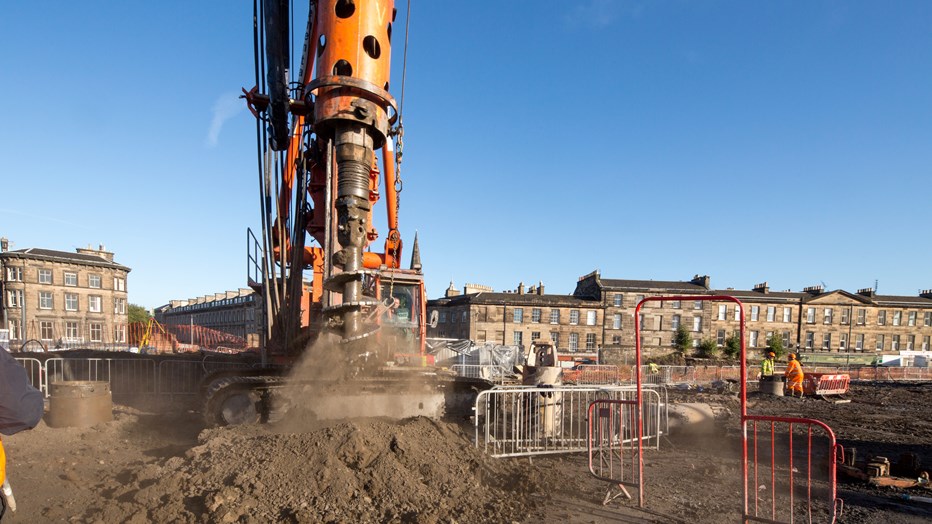For more than 50 years, Cementation Skanska has had a strong presence across Scotland, delivering piling and foundations solutions on some of the nation’s most complex building and infrastructure projects. This includes work on Haymarket Edinburgh, a high-profile mixed-use development.
On completion, Haymarket Edinburgh will provide more than 380,000 sq. ft of Grade A office space, a hotel, retail space and a vibrant landscaped public realm designed to be inclusive for the benefit of the local community where it is being built and the city’s business community. The £350M development is being developed by Qmile Group, designed by globally renowned architect Foster + Partners with Sir Robert McAlpine as the main contractor.
Due to the presence of two historic railway tunnels, which date back to 1846, the site has remained undeveloped for some time. The tunnels connect Haymarket and Waverley stations and any development had to be based on a piling and foundations solution that would preserve the integrity of the tunnels for generations to come.
Working in close collaboration with Sir Robert McAlpine and the project team, Cementation Skanska (Cementation) designed a solution that led to the installation of piles in-between and around the tunnels that ensured no loading from the new buildings would be transferred onto the existing tunnels. This was a complex element of the works, with the design of the piles critical to its success.
Piling over tunnels
To mitigate any vibration caused by the piling works on the tunnels, Cementation probed the pile positions within the zone of influence of the tunnels to identify any strong bands of strata, and then stitch drill any bands that may trigger vibration monitoring thresholds. This probing and additional drilling proved invaluable in identifying and minimising the impact of drilling through these hard rocks.
Preliminary tension and compression test piling was completed in 2015. Six months later the tension test was repeated to ensure that no load would be transferred to the tunnels.
Based on the success of the test piling, Cementation was appointed for the first two phases of work. Phase one saw the installation of 35 permanently lined piles. In late 2016, Cementation returned for phase two to install a further 48 lined piles and 60 tension and compression piles.
Logistics management
A major programme of earthworks removal was necessary to facilitate access to the north side of the tunnels. The earthworks removed approximately 6.5m of overburden from both the north and south tunnels. The limited space to the north of the tunnels only left room for the rig, so all material needed to be craned over from the south. With access restricted, a 200t crane with a 62m jib was needed to deliver loads of up to 12.5t to site. Cementation worked closely with Sir Robert McAlpine and the local community to manage site logistics and minimise disruption.
These site restrictions, combined with the need to pile around the tunnels, led Cementation to recommend the use of the lighter lined pile, rather than heavy gauge steel. It was also a more cost-effective solution.
Designing an efficient basement
After a break in the development, we returned to the site to build a 120m long contiguous piled wall to support the basement for buildings 4 and 5, which lie to the south of the railway tunnels. With the development progressing at pace and multiple contractors on site, we designed the wall to work in temporary cantilever. This freed up space and in turn mitigated the overall time required to construct the basement. Piles were installed up to depths of 18m with two rotary rigs and, in some sections, through 16m of bedrock to achieve the design toe levels.
Collaboration key to success
After a 12-week enforced shutdown due to the COVID-19 pandemic, we were able to resume on site. Following government guidelines and working closely with Sir Robert McAlpine, a smaller crew returned to site to pick up where we left off.
With a Cementation crew based locally, post COVID-19 travel became less of an issue. Because of the measures put in place on site and the team’s flexibility and commitment, we were able to keep to the original timescales with both phases completed within their contract programmes.
Working in close collaboration with Sir Robert McAlpine, Network Rail’s Asset Protection Team and Arup, exemplary safety standards were maintained throughout. Despite working on a complex and constrained city centre site, we completed foundation works to the highest quality standards and without incident or any Loss Time Accidents.
What’s next
We returned to the site in May 2021 to undertake the sixth phase of the piling works, completing the piling for buildings 4 and 5. This phase includes the installation of a further 42 bearing piles. Work on all phases at the Haymarket has certainly tested our expertise, but we have risen to the challenge playing a huge part in keeping the project on track.
We have offices and a permanent presence in Scotland, which means we can call on people who know the area, understand the geology and have the technical expertise to rise to the challenge. This is reinforced by the breadth and availability of our rigs and machinery, and well-established supply chain. We very much look forward to a further 50 years of success in Scotland.



